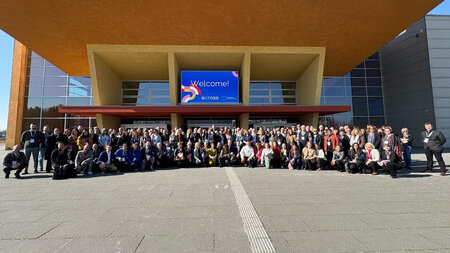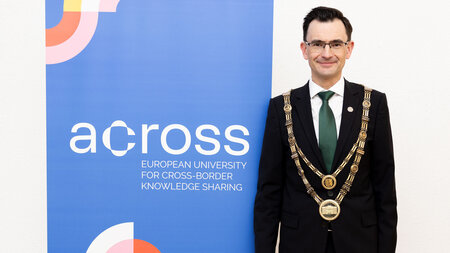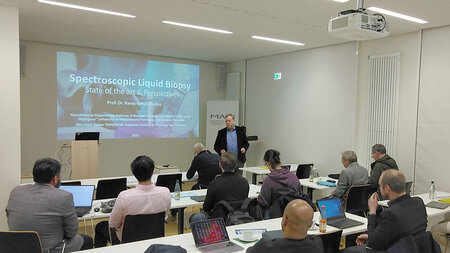More than just nice gestures
The gesture exhibition in the Chemnitz Museum of Industry has been opened, and convinced its first guests with an innovative blend of art and technology
-

“To see the exhibition take shape after more than a year of planning and intensive cooperation was a great experience for the whole team”, said Prof. Ellen Fricke at the opening event of the gesture exhibition before roughly 200 guests. True to the exhibition focus on gesture, all speeches at the opening ceremony were simultaneously translated into sign language. Photo credits: Bianca Ziemons -

Dr. Oliver Brehm, director of the Chemnitz Museum of Industry, emphasized the importance of the special exhibition. Photo credits: Bianca Ziemons -

Suitable for the occasion, the artist Carolina Eyck played her own compositions for the Theremin, the first instrument ever developed that is played without the hands. Photo credits: Tobias Naumann
The special exhibition “Gestures – in past, present, and future” in the Museum of Industry Chemnitz has been opened on Thursday, November 16, 2017. The exhibition runs until March 4, 2018. About 180 guests used the opportunity to experience the exhibition on 600 square meters in the special exhibition hall of the Museum of Industry Chemnitz. The foundation for the exhibition are results of the research project “MANUACT”, which was funded by the Federal Ministry of Education and Research (BMBF) and headed by Prof. Ellen Fricke, professor of German Linguistics, Semiotics, and Multimodal Communication at Chemnitz University of Technology.
The gesture researcher was very happy with the opening ceremony: “To see the exhibition take shape, after more than a year of intensive planning and cooperation with the Ars Electronic Futurelab and the Chemnitz Museum of Industry, was a great experience for the whole team. The opening of the exhibition lifted a burden from our shoulders. Now we can say that the concept is aesthetically pleasing and functions as we hoped it would do. The feedback of the first visitors seems to confirm that the exhibition works well for them.”
Exhibits for body and mind
Visitors were especially thrilled by the interactive exhibits. Sarah Börner, student of German language and literature, commented: “It’s great that there is a lot to try out and to discover with your hands.” The exhibition invites the participation of its visitors: they can experience digital pottery, braiding, or spinning, and much more. Almost all the 16 exhibits allow for some form of interaction. The result is a playful and relaxing atmosphere that fosters the curiosity of old and young. The visitors try their hands at the interactive exhibits, which results in laughter and conversation.
However, not everything was obvious or easy to solve. Börner: “The meaning and functionality of some exhibits has to be discovered”. This is the case with Berlin artist Annette Rose’s walk-in installation “Captured Motion”, a multi-channel video installation placed in a cube. It demonstrates the aesthetic potential of motion capturing as recording technology of co-verbal gestures and shows how words and gestures interact when people describe objects. Fellow student Sarah Halsema adds: “The exhibition shows how versatile gestures are and how little we are usually aware of them.” Both students especially liked the “Wooden Mirror” of New York artist Daniel Rozin which transforms a non-reflecting surface into a mirror and mimics the own movements with the help of about 800 wooden tiles that can change their position.
An exhibition that brings together different perspectives
The exhibition combines art and technology and manages to reach a broad audience. For example Thomas Fischer, an artisan who was fascinated by the possibility to experience technological developments of the future. He was especially fascinated by the exhibits of the Ars Electronica Futurelab, one of which demonstrates the interaction with self-driving cars: “The car has to recognize my gesture very preciselywithout mistakes, otherwise this could easily go wrong.” He was also positively surprised about the mixed audience: “There are so many different people, young and old, academics and artisans.” This attests to the fact that gesture research concerns everyone – we all use gestures in our daily communication.
Prof. Winfried Thielmann, professor of German as a Foreign and Second Language at Chemnitz University of Technology, was convinced by the exhibition. He admits that he had been sceptical, but then changed his opinion: “As a linguist, I thought that gesture had nothing to do with linguistics – but Prof. Fricke’s work has convinces me otherwise.”
Possibilities of nationwide success
With the exhibition, Ellen Fricke hopes to convince people from all over Germany. Fricke says: “This exhibition, with its exceptional combination of science and art, would not be necessarily expected to take place in a city the size of Chemnitz; one would rather connect it with cities such as Berlin, Cologne, or Munich. To quote, with some freedom, Ingrid Mössinger, the managing director of the Kunstsammlung Chemnitz: ‘Provincial is only what you allow to be.’ Both the Chemnitz University of Technology and the City of Chemnitz are often underrated, regarding the conditions and possibilities that they offer, but of course, you have to grasp them and make creative use of them.” The gesture exhibition presents an opportunity for unusual experiences and new perspectives. Until March 4, 2018, everyone can experience the special exhibition “Gestures – in past, present, and future” in the Museum of Industry Chemnitz.
Further information on the exhibits, on the research behind them, the museum education programme, and other aspects of the exhibition are available under: www.gesten-im-museum.de
Background: The MANUACT research project
How hands and objects fit together, how products are adapted to our hands, and how humans verbalize manual actions, are among the topics of the research project “Hands and Objects in Language, Culture, and Technology: Manual Actions at Workplaces between Robotics, Gestures, and Product Design” (MANUACT). In this research project, the professor of German Linguistics, Semiotics, and Multimodal Communication, and the professor for Ergonomics and Innovation Management at Chemnitz University of Technology cooperate with the Chemnitz Museum of Industry and with the Ars Electronica Futurelab in Linz (Asutria), which researches the intersection of art with technology and social issues.
Opening hours of the Chemnitz Museum of Industry: Tuesday to Friday 9 a.m. till 5 p.m. / Saturday, Sunday, holidays: 10 a.m. till 5 p.m. / Special opening hours on New Years Eve.
Further information on the exhibition is available from Dr. Oliver Brehm, email dr-brehm@saechsisches-industriemuseum.de phone +49 371 3676140 / Dr. Ellen Fricke, email secretariat.fricke@phil.tu-chemnitz.de phone +49 371 531 27220 (secretariat) / Christopher Lindinger and Marianne Eisl, email Christopher.lindinger@aec.at, Marianne.eisl@aec.at, phone +43 732 727280
A TV report on the opening ceremony of the gesture exhibition is available from the YouTube channel of Chemnitz University: http://bit.ly/Gesten
An instagram story on the opening is also on YouTube: http://bit.ly/2zkfeKT
Matthias Fejes
06.12.2017





